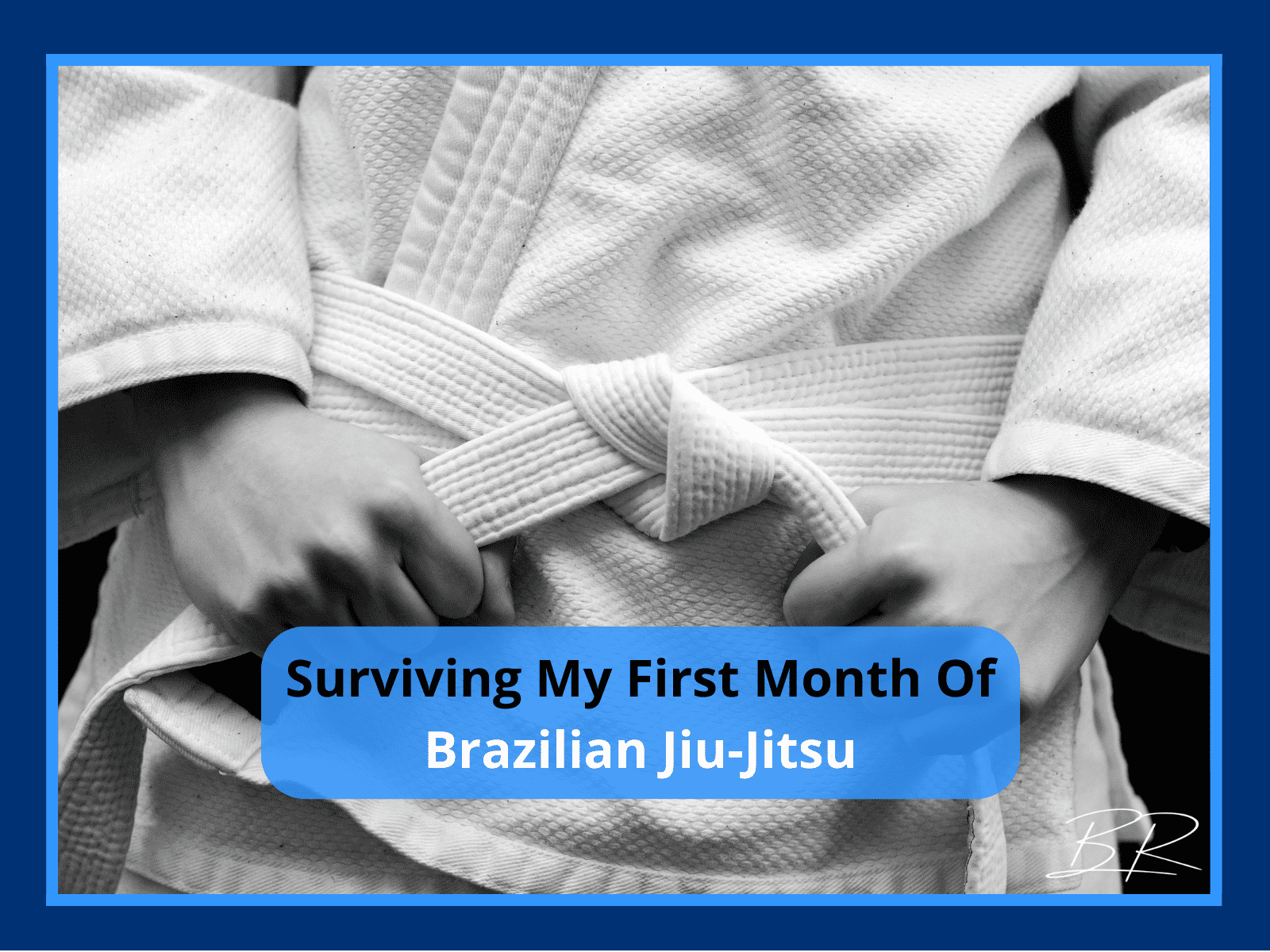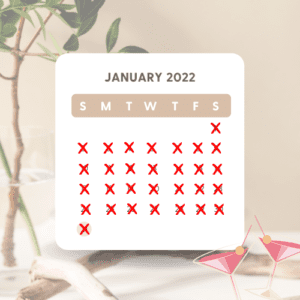BJJ – How I Survived My First Month of Brazilian Jiu-Jitsu
This post contains affiliate links that help supports this blog and cost you the exact same. If you do not wish to use affiliate links, then feel free to google the product.
Hey everyone! I’m a newbie (a new white belt in jiu-jitsu), and I just wanted to share my experience of how I survived my first BJJ class and then my first month of Brazilian Jiu-Jitsu.
It was overwhelming at times, and I found myself way out of my element countless times! But overall, it has been a fantastic experience, and I’ve learned so much.
If you’re considering joining BJJ or have just started out, this blog post is for you! Read on to find out what I went through and how you can survive your first month (and beyond) of BJJ too!
Why I got started in BJJ
When I first got started in Brazilian Jiu-Jitsu (BJJ), I was looking to fulfill a few things:
- I wanted to become more confident when traveling and to feel safer.
- I wanted to become a beginner again and learn something new.
- I wanted to know if my fitness and athleticism in other areas would cross over.
- I wanted to practice martial arts that did not involve striking.

I saw the sport as a way to learn self-defense while providing me with an enjoyable physical activity. BJJ is known as a very technical sport, but that doesn’t mean it’s inaccessible to beginners; the confidence and respect you gain after understanding even the basics of BJJ will make anyone feel safer when they’re out and about!
With discipline, patience, and passion, I began my journey into the world of BJJ, and I love it.
What I wish I had known my first day in Jiu-Jitsu
On that first day, I wanted to learn as much as possible; honestly, I thought it would have been easier.
Now, having survived my first month, I would like to offer guidance on a few things and hopefully help others enter the BJJ gym for the first time.
What to ask before your first BJJ Class
Take the time to get any questions or concerns answered before you go.
For example, I had no idea where the front door was, and I spent 10 minutes pulling on every door (all were locked) and walking around the building twice, trying to find the right entrance.
Ask what you should wear. For example, at my gym, they loaned you a Brazilian jiu-jitsu gi for the first class, so I wore gym shorts and a t-shirt.
I would also ask what the best first class for a beginner is. Most gyms will have several class types: open mat rolling, a question/answer period, and average BJJ classes with standard instruction. Some classes may be more focused on beginners, and others may focus on advanced students.
So it is best to start in an appropriate first jiu-jitsu class.
What to expect at your first BJJ class
First of all, Jiu-Jitsu is a very close and personal sport, and you should expect to have a lot of body contact with your training partner.
Before you choose your starting day, ensure you are healthy and feel comfortable (essentially) aggressively cuddling with others.

There will be times that you get choked, be pressured by someone else’s body weight, and feel stuck. This is all very normal, and you will get used to it.
Expect and be ready to tap. As a beginner, you will be tapping lots!
Brazilian Jiu-Jitsu Terms to know before you start
1. Gi: Traditional martial arts uniform.
2. Submissions: Techniques used to immobilize an opponent or force them to yield through pain or fear of injury (e.g., armlock, choke).
3. Mount: A top grappling position where the person is on top of their opponent’s chest and has one or both legs trapped between their opponent’s body and arms.
4. Guard: A bottom grappling position where the person is on their back, holds onto the top person’s body using their legs, and works to sweep them or submit them with submissions.
5. Takedown: A move to bring an opponent down from a standing position to the ground.
6. Half guard: A grappling position where one person is on the bottom and controls one of the opponent’s legs, usually trapping it between their own legs.
7. Side control: A top grappling position where the person is perpendicular to their opponent, controlling them with their body weight while pinning them onto the ground.
8. Closed Guard: A bottom grappling position where the person has both legs wrapped around their opponent, trapping them in place and working towards submissions or sweeps.
9. Open Guard: A bottom grappling position where the person keeps one leg in front of their opponent, usually trying to use that leg to control distance or sweep them.
10. Collar and Sleeve: Refers to grabbing the sleeve of the Gi in one hand and the collar in your other hand to control an opponent while standing.
11. Knee on belly: A top grappling position where one person has their knee on their opponent’s stomach controlling them with their body weight.
12. Spider Guard: A bottom grappling position where one person has their feet hooked on the biceps of the top person and uses their legs to control them.
13. Kimura: A shoulder lock submission that is usually done from side control or north-south position.
14. Armbar: An armlock submission where one person has their opponent’s arm trapped and attempts to hyperextend the elbow joint.

15. Choke: A submission technique where one person cuts off the air supply of another person by constricting the throat.
16. Roll: Also referred to as doing rounds. This is where you are encouraged to explore and challenge yourself against your partner by practicing the techniques you know in a live and dynamic setting. Free from the structure of a specific drill, rolling allows you to practice techniques in a live environment.
17. Tap: Signaling to your partner that you are submitting. This is done by tapping them on their body or verbally saying “tap” so they know to stop what they are doing.
18. Breakfall: A technique used when falling to the ground to minimize impact and help avoid injury. It involves rolling with the momentum of the fall to make it as safe as possible.
19. Gi Choke: A type of choke performed with the aid of your opponent’s gi. It is usually done from the collar by passing one arm under your partner’s chin and pulling on their lapel with the other hand.
20. Escapes: Techniques used to escape your opponent’s control and return to a neutral position. This could involve either getting out from underneath them or reversing the positions so that you are on top.
21. Turtle Position: A bottom grappling position where one person is on their hands and knees, with their head facing down and their back facing up. This position is often used to defend against submissions from the top person by exposing as little of your body as possible.
Techniques to know before your first day in Jiu-Jitsu
1. How to Wear a Gi: Make sure your gi is clean, free of holes, and not too baggy or tight. On your first class, you may be provided with a gym Gi, which is a great way to determine your size. To properly wear your Gi, you do the following:
- Pants: I wear athletic underwear underneath. Something like Saxx or Underarmor works well. With the pants, you want to pull the strings on the side to get the slack out, then tie the waste band rope at the front.
- Top: Most males will either train shirtless or with a rashguard. I wear a rashguard which is much more durable than a typical t-shirt.
- For the Gi Top. The left half goes over the right half. Often there are logos or a label on the left side to show on top.
2. How to Tie a Belt: While it may sound like a straightforward thing (and it is once you learn), it can be frustrating and embarrassing when you need to ask the instructor for help every time it comes off.
I recommend watching this video about five times while trying to try your own belt (do this before you go to class).
PS: if you don’t have a proper belt, use a belt from a robe or any other thin and narrow fabric.

3. Closed Guard: This is one of the fundamental positions in jiu-jitsu and involves the person on the bottom having their legs wrapped around the torso of their opponent, controlling them with their arms and legs.
4. Mount: This is a dominant position where the person on top has full body control over their opponent, using their weight and leverage to prevent escape attempts and then attempting a submission.
5. Side Control: A top grappling position where the person is perpendicular to their opponent, controlling them with their body weight while pinning them onto the ground. This is a key position for many different submissions and escapes.
These five positions and techniques will be brought up in almost every class, so it is helpful to understand what they are before you step in.
Etiquette for a Brazilian Jiu-Jitsu Class
1. Be clean: It is essential to be clean and healthy before attending a Brazilian jiu-jitsu class. Wear appropriate and clean attire, such as a rash guard or Gi for grappling. Make sure your nails are trimmed short and your skin is free of any open cuts or scrapes.
2. Line up according to belt rank: Students should line up in order of their belt rank before the start of class. This provides a sense of hierarchy and respect for instructors, more advanced students, and other less experienced students. Just follow other people’s lead and ask if you are unsure.

3. Bow: Upon entering and leaving the mat, some places encourage a bow to show respect. While this one will depend on the gym you are training at, follow others’ leads.
4. Respect instructors and other students: It is important to show respect towards everyone: instructors, more experienced students, and other less experienced students when attending a Brazilian jiu-jitsu class. Do not engage in any negative or trash talk inside or outside the classroom.
5. Training safely: Always train with safety in mind and use proper control when sparring with others. Never attempt to apply techniques on someone that is not comfortable, and never go too hard without your partner’s agreement. Respect your partner’s safety and limitations during class.
Note: As a reasonably strong person, I can get around some techniques by applying force. However, this is short-term thinking and will hurt me in the end, so I try to listen and follow the techniques and not just overpower my partner.
6. Listen to instructions: Follow all instructions given to learn the techniques correctly and safely. Do not talk while the instructor is teaching, and ask appropriate questions when needed. PS: People in class will often try to give you additional things to think about and try. This can be a double edge sword. Sometimes it is great feedback, and sometimes it is too much information. Use your best judgment to focus on what seems like the most important principles.
7. Have fun: Brazilian Jiu-Jitsu is meant to be enjoyed, so have fun with it! Enjoy each class, and don’t forget why you are there in the first place – to learn and improve your skills.
Following these etiquette rules will ensure that everyone in the Brazilian jiu-jitsu class has a positive experience and can learn and progress safely. Remember, jiu-jitsu is not just about technique; it’s also about respect and courtesy for others and being a part of a great community.
What my first month of training BJJ was like
My first month of training BJJ was challenging! I was frustrated with the lack of understanding of how to submit my opponents, and I felt unsure and uncoordinated in all of my moves.
There were so many different things to focus on at once – proper posture, grips, timing, and balance. My body was sore all over, and my mind was confused by the end of each session.
Despite the difficulty I experienced while learning my first few Brazilian Jiu-Jitsu moves, it was a lot of fun. There’s something special about getting frustrated and still wanting to come back and learn more. In each class, I feel more jigsaw puzzles coming together.
Expectations for your first month of BJJ Training
Establishing expectations ahead of time will help focus your efforts – decide what you want to get out of your classes and go in with an open mind.
It’s ok to take things slow to absorb new movements and etiquette; jits is a very complex sport, and the first month shows you just how much you have to learn.
In each class, I tried to focus on just a few principles and did my best not to get overwhelmed. Each move can be analyzed in extreme detail, but for a white belt beginner, it is important not to get lost in those details. Instead, try to focus on the principles and the overall objective of the move.
Warming up
A great way to warm up before jiu-jitsu class is to stretch your neck, shoulders, and hips.
To stretch your neck, you can turn your head side to side, looking over each shoulder and gently rolling your head in a circular motion.
Next, focus on your shoulders by gently lifting and dropping them; you can also roll them back and forth. I like doing cat-cows, scapular push-ups, and t-spine twists.
Finally, take care of your hips with a few lunges and gentle squats.
This warm-up routine should help prepare you and your body for the jiu-jitsu class.
How Often Should A Beginner Train BJJ?
As a beginner in jiu-jitsu, it is important to train regularly to develop techniques and skills. I believe you should train 2-3 times per week to make progress and see results, and yet not push yourself too hard while your body adapts.
While getting in as much mat time as possible is helpful, it is equally important that you listen to your body and take the necessary steps to ensure that you are not putting yourself at risk for injury. If you feel like you need more recovery time between sessions, reducing your training frequency or taking a day off is perfectly acceptable.
Ultimately, it is important to find a balance between pushing your body and allowing yourself enough rest for proper recovery so that you can continue to learn and enjoy jiu-jitsu without putting yourself in danger (or having to take a month off of training completely to recover).
What I struggled with the most in BJJ
Trying my hand at Brazilian Jiu-jitsu (BJJ) was difficult.
What I struggled with the most was not knowing the fundamental principles; without them, I couldn’t complete any advanced moves and submissions or many of the basic ones. And each move felt isolated and unique from the last one.
Applying body weight effectively and understanding how to close or open gaps was also much more difficult than it looked during demos.
I also had trouble understanding proper posture and grips. And without them, I stood no chance in maneuvering around my opponent.
My plan on learning continue to learn BJJ
Starting as a white belt in Brazilian Jiu-Jitsu (BJJ) is an intimidating but enriching experience.
I plan on immersing myself in training and watching as many instructional videos as possible:
- I plan on training 2-3 times per week at Pacific Top Team
- Gracie University’s 32 Principles course
- Bernardo Faria Fundamentals course
- Roger Gracie’s Blue Belt Essential course
In addition, continuing CrossFit 2X per week, snowboarding (for the remainder of the season), biking, and running (once the weather is warmer).
With this plan in place, I’m excited to continue to understand the fundamentals of BJJ better and make progress toward my next stripe and, eventually, belt.
Conclusion
I began my BJJ journey not knowing anything about the sport or what to expect.
If I had known then what I know now, my first day would have been a lot less intimidating. If you’re thinking about trying Brazilian Jiu-Jitsu, I urge you to stop thinking and go for it. It’s an incredibly rewarding experience that will push you physically and mentally in ways you never thought possible.
Trust me, your first month of training will be challenging, but it’ll be worth it when you see the progress you make.
So what are you waiting for? Get out there and give BJJ a try!







